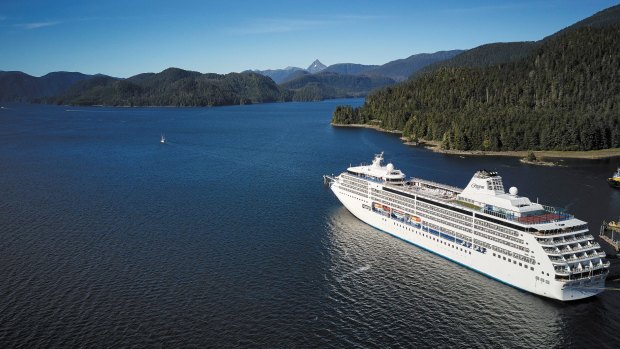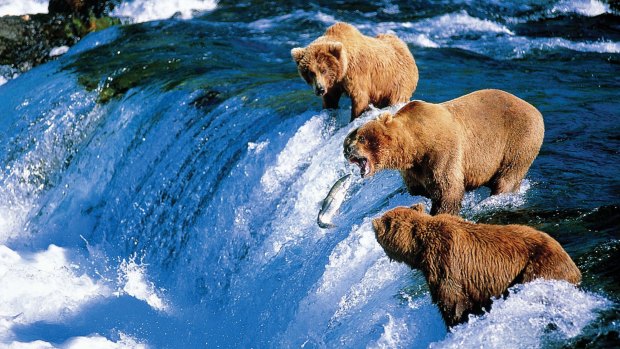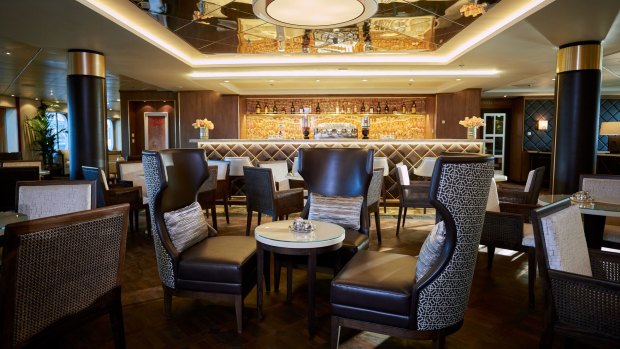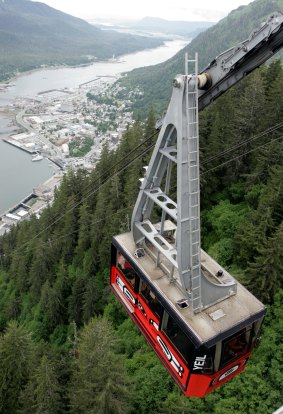This was published 4 years ago
Cruising Alaska: What you need to know about going on a cruise in Alaska

Mariner in Alaska.
Everything about Alaska is big. At twice the size of Texas and about three times as big as France, it's the largest state in the US. It has nearly 55,000 kilometres of coastline, 3 million lakes and boasts the highest mountain in North America, Mount Denali. Even its famous wildlife is supersized – Alaska is home to the nation's largest bald eagle population, its polar bears and brown bears compete for the world's biggest bear title, Alaskan moose top the global scales and among the eight or nine whale species that cruise the region, the endangered blue whale – yes, you guessed it, the biggest in the world – has been spotted in Alaskan waters.
And now Alaska has just experienced its biggest-ever cruise season, while 2020 looks like it will outdo even that. A record-breaking 1.2 million passengers sailed on a plethora of ships that range in size and style from megaships Norwegian Joy, Norwegian Bliss and Ovation of the Seas to UnCruise Adventures' boutique motoryacht, the 22-passenger Safari Quest.
BIG CHOICE

Alaska brown bears filling up on salmon.
Holland America Line and Princess Cruises dominate with their mid-size ships; each line has eight ships sailing in Alaska next season. Norwegian Cruise Line comes a close third in terms of passenger capacity – Norwegian Joy and Bliss between them accommodate about 8000 passengers. Other mid-size ships heading north include Norwegian Jewel and Sun, Celebrity Cruises' Eclipse, Millennium and Solstice, and Cunard's Queen Elizabeth.
Smaller ships venturing into the Last Frontier include Oceania Regatta, Ponant's Le Soleal and two from Lindblad Expeditions. On the ultra-luxury front, Seabourn Sojourn is in Alaska from June to October, Silver Muse from May to September, and Regent Seven Seas Mariner from June to September.
LAP OF LUXURY

On board Regent Seven Seas Cruises.Credit: Stephen Beaudet
Recently I sailed from Vancouver to Anchorage onboard Seven Seas Mariner and I'm still revelling in the memories. Luxury cruising doesn't appeal to everyone – young families tend to go for activity-packed megaships or expedition-type ships for wilderness adventures and many cruisers are frightened off by higher price tags. However, it's well worth considering how much is included in the fare, when comparing a luxury ship to a premium one.
Regent Seven Seas includes an impressive selection of shore excursions, plus all drinks, specialty dining and staff gratuities on all its voyages; these extras can add up to a hefty sum over a seven-day cruise. Dining at specialty restaurants can eat away at your budget and several lines now charge for room service as well. Another reason for higher fares is the higher level of service – on Seven Seas Mariner 445 crew members look after a maximum of 700 guests, whereas most premium or "contemporary" ships have a much lower crew to guest ratio.
Of course, it is all about personal choice, and most ships, whatever budget bracket they fit into, call at more or less the same ports on a typical seven-night Inside Passage itinerary. It's what you do when you disembark that makes an Alaskan cruise so awe-inspiring – that and scenic cruising around magnificent Glacier Bay National Park, College Fiord or Hubbard Glacier.

The Mount Roberts tramway affords a bird's-eye view of Juneau.
PORT HIGHLIGHTS
Ketchikan is Seven Seas Mariner's first port of call after sailing for a night and day from Vancouver. Even though we are surrounded by snow-streaked mountains the sky is clear and a few devoted sun-worshippers are lazing by the pool before everyone disperses on their chosen adventures.
Having previously taken a terrifying zipline trip over the rainforest in Tongass National Forest – terrifying because I only did it to overcome my fear of heights and then got stuck between skybridges, dangling hundreds of feet above the treetops – this time I choose a more contemplative experience.
The Totem Heritage Centre is a short walk from the waterfront gold-rush-era boardwalks and stilt houses and is a quietly compelling introduction to the region's indigenous heritage. It houses an extraordinary collection of 19th-century totem poles, along with contemporary north-west coast art and traditional artefacts made by Tlingit, Haida and Tsimshian people.
Juneau, Alaska's capital, offers such a vast choice of adventurous trips it is hard to pick one without suffering a severe case of FOMO. Choppering out to land on Mendenhall Glacier for a trek on the ice or a thrilling dog-sledding ride? Canoeing to the face of the glacier? A floatplane trip to Taku Glacier Lodge? Then there are foodie and brewery tours, gold-panning treks and twilight whale-watching cruises … but if the budget allows, you can't go past the full helicopter and dog-sledding experience.
In the city itself, Mount Roberts Tramway is conveniently close to the dock and the speedy ascent to the stop-off point 550 metres up the mountain affords a bird's-eye view of Juneau and the Gastineau Channel. From there you can follow well-maintained hiking trails to the summit or walk back down through the forest, keeping your eyes peeled for sightings of bald eagles, deer, mountain goats and porcupines.
Gold-rush stories, many of them desperately tragic, lie at the heart of the little town of Skagway. They are re-told on trains that run on the White Pass Scenic Railroad, a spectacular journey that winds its way to the 915-metre White Pass summit through 32 kilometres of precipitous mountain passes and gorges alongside the Chilkoot Trail. In the 1890s, thousands of stampeders walked this daunting trail in search of their fortunes in the Yukon and evocatively named places such as Dead Horse Gulch bear witness to their travails.
Sitka's history is different again. Centuries of Tlingit ownership were followed by Russian colonisation in the 1700s, until the Russians famously sold Alaska to America in 1867 for US$7.2 million, or about two cents an acre. It's hard to imagine that this pretty coastal township on Baranof Island was once the capital of Russian America – then named New Archangel – but monuments such as St Michael's Cathedral and Totem Park remind you of Sitka's complicated heritage.
For the first time on this cruise, the weather turns from crisp and bright to cold and damp. Perhaps not ideal conditions for sea-kayaking but I am determined to make the most of my last chance to see brown bears in the wild. In a big shed on the pier, where fishermen are sorting their nets and exchanging laconic comments, we suit up in heavy-duty wet weather gear and embark on a high-speed boat ride to the floathouse at Camp Coogan Bay.
Here, two guides lead our little group across mirror-like water and in and out of misty bays surrounded by brooding spruce and hemlock trees. Seabirds wheel overhead and the only sound breaking the hypnotic silence is the splish-splash of our paddles – until one of the guides tells a funny story about a hoax bear sighting.
While I don't get to see the real thing (I'm told by a guide that late July is the best time for bear-spotting), I know they're out there – as a favourite travel quote goes, all you need to know is that it is possible.
TRIP NOTES
CRUISE
Seven Seas Mariner will cruise in Alaska from June to September 2020. Fares for seven-night itineraries between Vancouver and Seward start from $6690 a person.
MORE
Sally Macmillan travelled as a guest of Regent Seven Seas Cruises
FIVE THINGS TO KNOW ABOUT ALASKA
ICY POLL
There are about 100,000 glaciers in Alaska, covering 5 per cent of the state; 616 of them are officially named. Glacier Bay National Park has about 1000 glaciers, including seven tidewater glaciers that calve into salt water at sea level.
BEAR-SPOTTING
Alaska is home to three types of bears: black bears (Ursus americanus), brown bears (Ursus arctos) and grizzly bears (Ursus arctos horribilis) – brown bears and grizzly bears are the same species – and polar bears (Ursus maritimus). The best time to see brown bears is from July to early September, when salmon are spawning.
WEATHER
Prepare for changeable conditions. On average, Alaska's summers are slightly wetter than the rest of the US. May is dry, with only a 25 per cent chance of measurable rain on any given day. It gets rainier as the summer progresses. By August, the chance of rain is just over 50 per cent.
MIDNIGHT SUN
The longest day of the year is June 21, when Anchorage experiences 19 hours of daylight and Fairbanks 22 hours. Alaska's sky is light almost all night from late May to late July and until at least 10pm for another month on either side of that period.
STATE SPORT
Dog mushing is Alaska's state sport. The Iditarod Trail sled dog race, a punishing 1600-kilometre slog from Anchorage to Nome that takes eight to 20 days to complete, is held every March. Mushers enter with teams of 14 dogs – this year 52 mushers took part and the winning team made it in 9½.
Sign up for the Traveller Deals newsletter
Get exclusive travel deals delivered straight to your inbox. Sign up now.